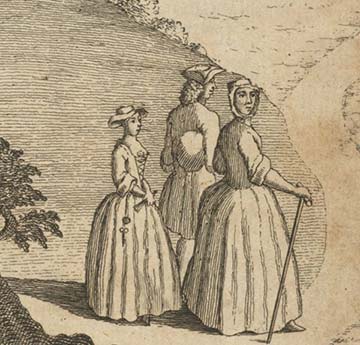Local History Society Report
Women of Property: The role of women locally at the end of the 17th century
Report of talk by David Cant
Tuesday, 29 September 2020
As David Cant launched the online Autumn series of lectures for the Hebden Bridge Local History Society, an audience of more than eighty people were logged into the 21st century phenomenon of a 'Zoom webinar' ready to be transported back to the seventeenth century. David was exploring the documentary evidence for the role of women at this time, especially using surviving wills and inventories.

Our ideas about women might be influenced by the images in portraits, but these tend to be restricted to the wealthier classes. Guides to conduct printed for the growing middle classes offer another glimpse of the domestic accomplishments women were expected to exhibit, and expressed in the words of Northowram's dissenting cleric Oliver Heywood, who praised his wife as 'provident and prudent' in her management of the home. However these depictions are partial.
Life in the Calder Valley could be hard, with the majority of the large parish of Halifax being predominantly rural, and dependent on the dual economy of agriculture and textiles. Halifax could be seen as remote, but there were links to ports and to other market towns which enabled the parish to benefit from the expansion of trade at this time. Local visitors gave mixed reviews: Celia Fiennes decided to avoid the town as it was 'so stony and ruined'. Daniel Defoe on the other hand was impressed by the industry of the people 'all full of business.'
Local documents such as Court rolls have very few mentions of women, who mainly faced charges such as selling underweight bread. Very telling though is the conviction in April 1688 of Mary Wilkinson and Mary Robert for 'common scolds'. They were sentenced to be 'cucked' - that is ducked on the cuckstool into the river. Obstreperous women were perhaps not to be tolerated. On the other hand, documents also suggest that women could have power, and another Wilkinson, Dorothy, is recorded in 1689 as owning two fulling mills and a messuage in Warley.
The most revealing documents are probably the wills and probate documents from Halifax Parish that local groups have been transcribing and publishing, covering the last twelve years of the seventeenth century. Fewer than 30% of the population made wills, and locally only about 1 in 15 of these were women.
The main focus of wills was to dispose of land and property, and women feature prominently as beneficiaries. The established local custom was that a widow received a third of her husband's personal wealth and property, and land and buildings were often used to finance legacies for annuities or to give lump sums to daughters and sisters. Most wills showed some equivalence in their provision for male and female descendants, though the males most commonly inherited the real estate.
Wives and daughters appear too as executrixes, with one example of a thirteen year old appointed to execute her father's will, and nominating the wife of the Heptonstall curate to undertake the task in her stead. Such renunciations were not common though and most women took up their appointed role.
From the six townships around Hebden Bridge thirteen out of 84 sets of documents were wills made by women, the majority being widows. Martha Eastwood of Fallingroyd (Follanroyde), a spinster, left a chest, a desk and a saddle and some riding clothes to two named individual women, and also made monetary bequests to a further 25 possible relatives. Her household goods amounted to less than £8, but she had money out on loan totalling £95 – a considerable amount.
Grace Travis of Stansfield, a widow, also made monetary bequests to her young relatives, of amounts between £20 and £80 and also left land to her brother. A niece received some of her household goods, a relatively modest collection of possessions. Most of Grace Travis's wealth was in the money that she had out on loan – there were fifteen such loans, all to men. Most were for small amounts, but she had lent to £350 to a Richard Patchett. The credit that was available from rich widows like Grace Travis may well have been providing capital for the growing textile industry. Such examples are found throughout the Calder Valley.
David pointed out that women were invariably defined in these documents by their marital status while men were described by their occupation or social status, but the documentary evidence challenges this stereotype of the passive and domestic female. Women were clearly playing a wider role in the commercial life of the Calder Valley.
Following from the successful launch of our on-line lectures, members and non-members are invited to join the Zoom webinar on Wednesday 14th October at 7.30 when Mary and Geoff Twentyman will be talking about The Explosion at the Low Moor munitions factory in 1916.
You can email Rachel Smith for details of how to join the society or register for a lecture. Further information at Local History Society website where you can also buy the newest book of probate transcriptions covering Heptonstall and Wadsworth townships. (Also available from the Bookcase in Hebden Bridge.)
Details of the talks programme, publications and of archive opening times are available on the Local History Society website and you can also follow the Facebook page.
With thanks to Sheila Graham for this report
See also

